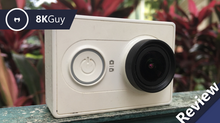Mi Powerline WiFi Adapter Review
- 8K Guy
- Nov 1, 2017
- 4 min read

Ever since I got the Mi WiFi Extender 2, WiFi speed in my room has greatly improved. However, downloading files was still really slow. Will the Mi Powerline WiFi Adapter be able to bump up my room WiFi speeds? Continue reading to find out.
Unboxing & Design - Very Promising
The Mi Powerline WiFi Adapter comes in two pieces, both contained in one long white box. Pulling off the lid of the box, we are greeted with two similar looking white blocks, as well as a booklet containing the instructions for setting up.
The first piece on right looks a lot like to the Mi WiFi Extender Pro, with antennas on the sides. On the bottom, you will find a white Ethernet port, which you can connect your laptop to. This piece goes in the room with weak WiFi.
Moving on to the second piece on the left. Unlike the first, this does not have any antenna. It has a blue LAN port at the bottom. Connect this to your router. Note that LAN cables is not provided, so you will have to get them separately.
Both pieces have matte plastic exteriors that look really modern, especially with the new white color. Paired with a plain, unobtrusive design, the Mi Powerline WiFi Adapter looks really sleek compared to competing products from TP-Link and Aztech.
My biggest issue with the design would be the button, positioned at the bottom of both pieces. Like the reset hole on the WiFi Extender Pro, you can't see it when plugged in. Fortunately, it is a protruding button this time, so at least you can feel it.
The Mi Powerline WiFi Adapter uses the China two-prong plug.
Setup - A Nightmarish Process
To setup the Mi Powerline WiFi Adapter, you will have to download the Mi Home app. Plug both pieces nearby and add 小米WiFi电力猫 as a new device in the Mi Home app. After setting the name and password of the new WiFi network, leave the app to do its work.

Theoretically, the Mi Powerline WiFi adapter should work after that. But while setting up, I met with a couple of issues that hindered the setup process. I was only able to get it set up properly after switching over to my Redmi Note 4 from my iPhone SE and attempting multiple times.
Once the setup process is done, the light on the piece with antennas should turn from yellow to blue. Then, you can shift it to your desired room. Do note that every time you power it off, it will take some time to reconnect and for the light to turn blue again.

Unlike the Mi WiFi Extender, there isn't much you can do in the app for the Mi Powerline WiFi Adapter. You can view the devices connected to the network and change the network's name and password, but that is about all there is.
Speed - Highly Dependent on How You Connect It
Okay, before we continue, there is one thing you need to know. Despite supporting 300Mbps WiFi as stated on the box, the LAN port is only 10/100, which means that speeds are capped at 100Mbps. Prepare to be disappointed if you are looking for anything more.

I do not have any China two-prong wall sockets in my house, so I will be using adapters for this review and that may have affected the speed. For me, the Mi Powerline WiFi Adapter performed noticeably better than the Mi WiFi Extender 2/Pro.
When plugged into the right wall socket, I was able to consistently get around 45-50Mbps for both upload and download on The Singapore Broadband Speed Test, using the Mi Powerline WiFi Adapter. Ping was also consistent at around 20ms,

Meanwhile, the Mi WiFi Extender Pro wasn't very consistent when it came to download speeds, providing around 30Mbps uploads/downloads at best, sometimes falling down to single digits. Ping was lower for the Mi WiFi Extender, at around 5ms.

But how do they fare under actual everyday usage? For YouTube, both had no problem loading 4K videos smoothly. Jumping across different time-stamps, the video took less than a second to buffer before playing again. Both have no problem with video consumption.
Downloading a 319MB file from LineageOS, the Mi Powerline WiFi Adapter downloaded the file in 2 minutes 20 seconds. After deleting the file and emptying recycle bin. I repeated the test with the Mi WiFi Extender Pro and it took 7.5 minutes. What a difference.
Note that your results will depend on how you connect the Powerline Adapter. There are many factors that affect the speed and probably the most significant of them would be extension cords and wall adapters. Try to avoid those whenever possible.
Conclusion - Not For Singapore Consumers
Just take a look at any powerline adapters and you will really appreciate the elegant design of the Mi Powerline WiFi Adapter. Competitors often use glossy plastic and brick-like form factor as if they are still in 2010. There is simply no comparison.
The Mi Powerline WiFi Adapter also beats the competition in price. It costs approximately S$50 and additional pieces at S$30 each. Similarly specced starter kits by Aztech and TP-Link costs more than S$80, with every extra extender piece costing over S$50.

If you live in Singapore and are thinking of getting the Mi Powerline WiFi Adapter, I do not recommending doing so. While it is a lot more affordable, not only is the setup complicated, you also need a China two-prong adapter, resulting in an eyesore, as well as possible speed lost.
Powerline extenders may not work for everyone due to the layout of the electric wiring. In some cases, WiFi extenders may be better, so if one doesn't work well for you, try the other.




























































Comments